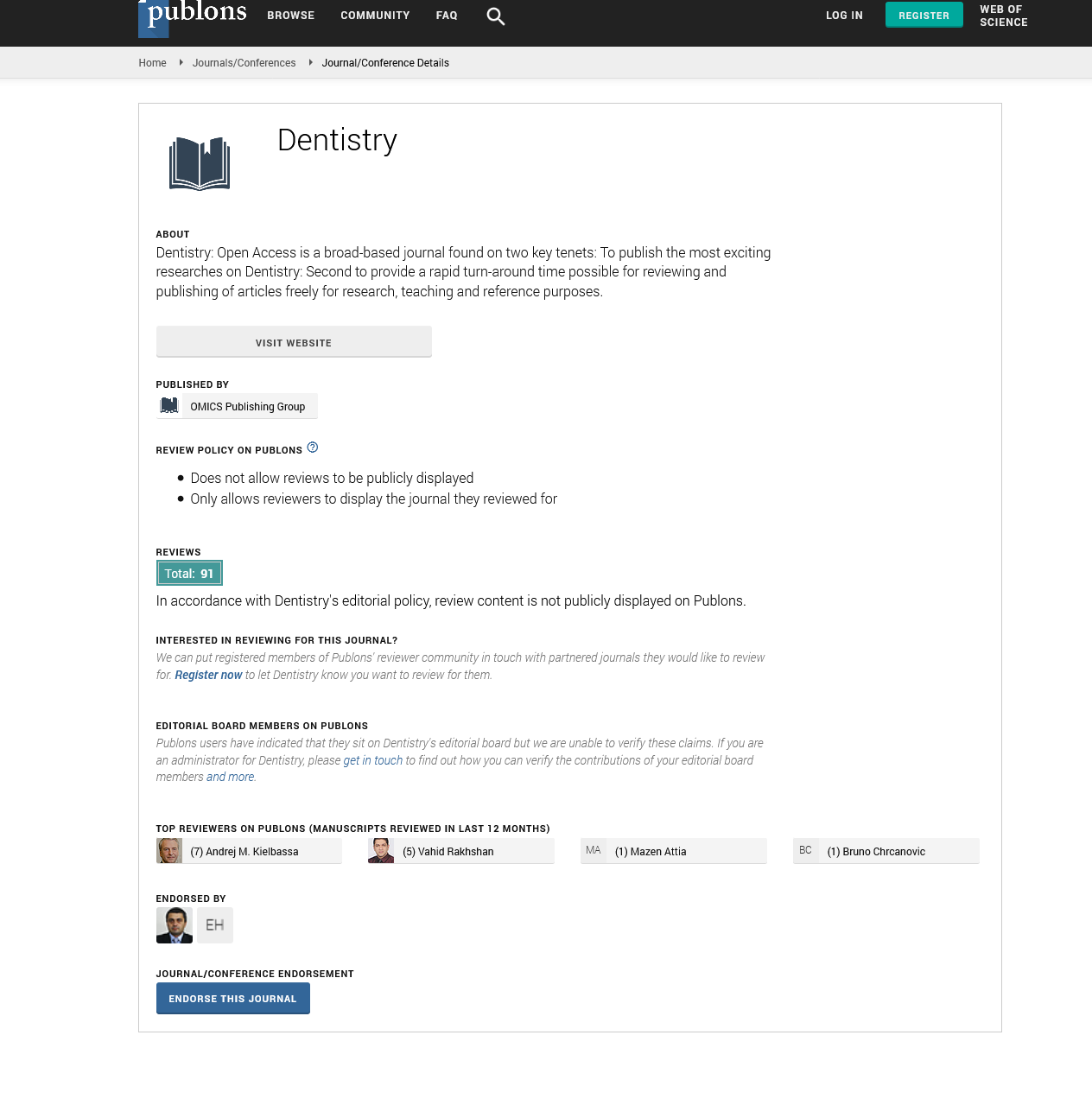Citations : 2345
Dentistry received 2345 citations as per Google Scholar report
Indexed In
- Genamics JournalSeek
- JournalTOCs
- CiteFactor
- Ulrich's Periodicals Directory
- RefSeek
- Hamdard University
- EBSCO A-Z
- Directory of Abstract Indexing for Journals
- OCLC- WorldCat
- Publons
- Geneva Foundation for Medical Education and Research
- Euro Pub
- Google Scholar
Useful Links
Share This Page
Journal Flyer

Open Access Journals
- Agri and Aquaculture
- Biochemistry
- Bioinformatics & Systems Biology
- Business & Management
- Chemistry
- Clinical Sciences
- Engineering
- Food & Nutrition
- General Science
- Genetics & Molecular Biology
- Immunology & Microbiology
- Medical Sciences
- Neuroscience & Psychology
- Nursing & Health Care
- Pharmaceutical Sciences
Opinion Article - (2025) Volume 15, Issue 1
Evaluating Esthetic Stability in Veneered Zirconia Anterior Restorations
Carina Belli*Received: 25-Feb-2025, Manuscript No. DCR-25-28553; Editor assigned: 27-Feb-2025, Pre QC No. DCR-25-28553 (PQ); Reviewed: 13-Mar-2025, QC No. DCR-25-28553; Revised: 20-Mar-2025, Manuscript No. DCR-25-28553 (R); Published: 27-Mar-2025, DOI: 10.35248/2329-9088.25.15.717
Description
Zirconia-based restorations have gained popularity in restorative dentistry due to their strength, esthetics and biocompatibility. When used in anterior Partial Fixed Dental Prostheses (PFDPs), zirconia frameworks are often veneered with a ceramic layer to enhance esthetic outcomes. However, concerns related to longterm performance, veneer chipping and framework stability necessitate clinical evaluations over extended periods.
Prosthesis fabrication
Zirconia frameworks were fabricated using Computer-Aided Design and Computer-Aided Manufacturing (CAD-CAM) technology. The veneering ceramic was applied using a layering technique to achieve a natural esthetic appearance. Proper occlusal adjustments were made to minimize excessive stress on the veneering material.
Survival rate and structural integrity
Over the 12-year period, the survival rate of veneered zirconia anterior PFDPs was 89%. A total of 11% of prostheses required either major repairs or replacement. Framework fractures were rare, occurring in only 3% of cases, while veneer chipping was observed in 17% of prostheses. Among the cases of veneer chipping, 60% were minor and could be repaired intraorally, whereas 40% required laboratory intervention.
Marginal adaptation
Marginal integrity remained stable in most cases, with only 7%of restorations exhibiting noticeable marginal discrepancies over time. These discrepancies were mostly related to cement degradation rather than zirconia framework distortion. No significant secondary caries or structural failures were noted at the abutment level.
Esthetic performance.
The veneered zirconia restorations maintained esthetic qualityover the years, with no significant discoloration or staining.Surface glazing and polishing procedures during recall visitscontributed to long-term color stability. Patients reported highsatisfaction with the natural translucency and lifelike appearanceof the restorations.
Periodontal health
Periodontal evaluations showed no significant increase ingingival inflammation or recession associated with theprostheses. Proper contouring and polished surfaces minimizedplaque accumulation. Cases of mild inflammation were linked toinadequate oral hygiene rather than prosthesis design.
Patient satisfaction
Patient-reported outcomes revealed high levels of satisfactionregarding function and esthetics. A questionnaire assessingcomfort, esthetics and chewing efficiency showed that 91% ofpatients were pleased with their restorations. The most commoncomplaints were related to minor chipping and occasional foodimpaction around the prostheses.
Strength and durability
The zirconia framework demonstrated excellent structuraldurability, with minimal fractures over the 12-year period. Thissupports previous findings that zirconia offers sufficient strengthfor anterior PFDPs. However, veneer chipping remains a concernand requires continued improvements in material processing andlayering techniques.
Veneer chipping and bonding considerations
Chipping of the veneering ceramic was the most frequentlyreported mechanical complication. Studies suggest that the difference in thermal expansion coefficients between zirconia and veneering ceramics, combined with functional loading, contributes to veneer fractures. Alternative fabrication techniques, such as monolithic zirconia restorations or improved bonding strategies, could help reduce this issue.
Esthetic longevity
The esthetic outcomes of veneered zirconia PFDPs remained stable, with minimal color change over time. Proper selection of ceramic layering materials and periodic polishing were effective in maintaining an esthetic appearance.
Clinical recommendations
To optimize the long-term success of veneered zirconia anterior PFDPs, the following considerations should be taken into account.
Proper framework design: Adequate support for the veneering ceramic minimizes stress concentration.
Material selection: High-strength veneering ceramics with better compatibility with zirconia frameworks should be used.
Occlusal adjustments: Reducing excessive functional loads on the veneering layer can lower the risk of chipping.
Regular follow-ups: Periodic evaluation and maintenance procedures, such as polishing, can enhance esthetic longevity.
Veneered zirconia anterior PFDPs demonstrated high survival rates and maintained esthetic integrity over a 12-year period. While the zirconia frameworks showed excellent durability, veneer chipping remained a common complication. Strategies to improve bonding techniques, enhance material properties and refine occlusal adjustments can contribute to better long-term outcomes. Overall, these restorations provided functional and esthetic benefits, with a high level of patient satisfaction.
Citation: Belli C (2025). Evaluating Esthetic Stability in Veneered Zirconia Anterior Restorations. J Dentistry. 15:717.
Copyright: © 2025 Belli C. This is an open-access article distributed under the terms of the Creative Commons Attribution License, which permits unrestricted use, distribution, and reproduction in any medium, provided the original author and source are credited.

